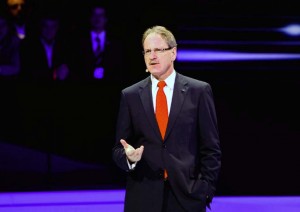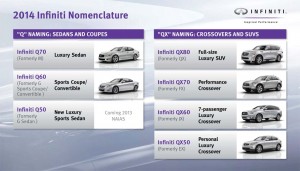When Infiniti unveils a new premium sports sedan at the Detroit Auto Show, next month, it will be badged the Q50 – making it the first product to adopt the luxury maker’s new alphanumeric nomenclature.
Going forward, all Infiniti passenger cars will carry the Q badge followed by a two-digit number that signifies its position in the marque’s hierarchy, from entry-luxury to flagship. Sport-utility and crossover models will follow a similar pattern, but beginning with QX.
“The reason we’re going through this change is that we’re on course for a significant expansion of our product portfolio,” explained Infiniti president John de Nysschen during a global media teleconference. But equally important, the recently appointed executive added, “We’re at a major inflection point as we embark on globalization.”
The new naming strategy harkens back to Infiniti’s early days. The then-new Nissan Motor Co. luxury brand was introduced in 1989 with two models, including the flagship Q45. Over the years, Infiniti has struggled to find a clear brand identity – and to stand up to better-selling competitors such as Mercedes-Benz, Audi, BMW and Toyota’s luxury brand, Lexus, which was also launched in 1989.
Largely focused for most of its first two decades on the U.S. market, Infiniti has begun a rapid global push, with an emphasis on emerging markets, such as China. Indeed, that was a key reason, company officials say, why the brand moved its headquarters from Japan to Hong Kong earlier this year.
South African-born de Nysschen was hired to oversee the transition. He spent much of his career with Audi – which uses a very similar nomenclature, starting with models like the A3 and A4 and moving up to the flagship A8 sedan. Perhaps not so ironically, Audi’s utes carry the Q designation, from the little Q3 to the full-size Q7.
The transition at Infiniti will begin in mid-2013 when the Q50 rolls out. It will be an all-new replacement for the current G sedan. But the rest of the line-up will switch to the new nomenclature as 2014 models reach showrooms. The Infiniti G coupe and convertible models will be renamed Q60. And the current top-of-the-line Infiniti M will be renamed the Q70.
The current base crossover, the EX will become the QX50, the recently introduced Infiniti JX will be rebadged the QX60. The FX, a performance crossover, will become the QX70, and the full-size QX SUV will be known as the QX80.
Going forward, de Nyssychen broadly hinted, the maker will add new models at both extremes of its line-up, likely filling currently empty spaces for models such as a compact luxury sedan that might become the Q30 or Q40, as well as the long-awaited successor to the original Q45 – which could become a new Q80.
The decision to go with a relatively uniform naming strategy could generate some pushback – both from buyers and analysts, de Nysschen conceded.
“One of the costs (of the switch) is the equity embedded in the current nomenclature,” he acknowledged. It could cost the maker tens, even 100s of millions of dollars to establish the new names, several industry analysts suggested.
On the other hand, the Infiniti chief noted that the brand is relatively unknown outside the U.S. and would likely have to market the old names in places like China, anyway.
He also suggested that when the name changes were run by Infiniti owners and potential buyers in consumer clinics, barely one in seven were negative about the move while nearly two in three saw it as a positive switch.
“The new Infiniti naming convention is intuitive and it will make it relatively easier for consumers to remember the various models in their lineup,” said Jesse Toprak, Senior Analyst at TrueCar.com. “However, at the end of the day, it’s the consumer acceptance of actual products that will dictate the success of the brand. The new Q50 that will be unveiled at the Detroit Auto Show will have more direct impact on Infiniti’s future performance than the change in their model names.”


